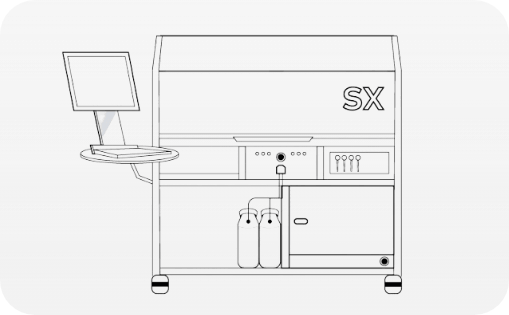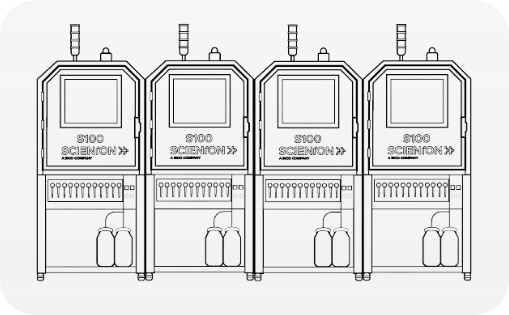Microfluidics
Building the Future of Lab-on-a-Chip with Scalable Precision
Microfluidics is the science and technology of controlling and analyzing very small volumes of liquid within microscale channels, which are often less than a millimeter in width. These channels are typically fabricated in materials such as glass, silicon, or polymer substrates and are used to transport, mix, separate, or analyze fluids with high precision. The concept, widely referred to as “lab-on-a-chip,” is an application of microfluidics and has transformed experimental design by condensing entire laboratory workflows into miniaturized and highly efficient systems.
By shrinking fluid handling to the microscale, microfluidic systems enable faster reactions, reduced reagent consumption, and seamless integration of multiple steps within a single device. They also conserve precious biological samples by requiring small volumes of input material. Another advantage includes the ability to run multiple assays simultaneously on a single chip, supporting complex and multiplexed analyses.
These features have made microfluidics central to diagnostics, drug discovery, and life science research. In healthcare, microfluidic platforms are powering innovations in infectious disease testing, cancer detection, and liquid biopsies. In environmental monitoring, they enable testing of water quality and contaminants, and in research, they support single-cell analysis and high-throughput screening, advancing fields from genomics to synthetic biology.
SCIENION technologies support these advancements with its sciFLEXARRAYER series, which provides ultra-low, precision dispensing for microarray and cartridge development, and its sciPOLY3D technology, which enables biomolecule immobilization on unmodified polymer surfaces. SCIENION solutions make it possible to integrate DNA, RNA, and protein assays into microfluidic devices, delivering reproducible, multiplexed, and scalable workflows.
Trusted by






Microfluidic APPLICATIONS

Surface functionalization of Lab-on-a-Chip devices
SCIENION precision microdispensing enables accurate positioning of biomolecules, such as DNA, antibodies, or proteins, onto microfluidic chips.

Reagent Loading for Point-of-Care Cartridges
sciFLEXARRAYER aliquots picoliter–nanoliter volumes of enzymes, primers, antibodies, or buffers into reservoirs and reaction sites before lyophilization or film sealing.

Microchamber Seeding for Digital & Compartmentalized Assays
Precision microdispensing loads microchamber arrays or partitioned structures with samples, standards, and oil overlays, critical for digital PCR and other compartmentalized assays.
Precision That Shapes Every Microfluidic Design.
Whether your application is environmental monitoring, diagnostics, or advanced research, SCIENION’s sciFLEXARRAYER systems enable the fabrication and functionalization of microfluidic and lab-on-a-chip devices with unmatched precision, reproducibility, and scalability. From early prototyping to high-throughput manufacturing, our technology ensures consistent results, accurate reagent placement, and effortless transition from concept to production.
Featured Resources

PUBLICATION
Precision for Microfluidic Discovery in Science Journal
In a landmark Science study published in June 2025, a global interdisciplinary team used the sciFLEXARRAYER S3 to precisely spot DNA for parallel enzyme assays in microfluidic chips. They powered 1792 simultaneous experiments with high reproducibility and near-zero cross-contamination. This piezo-driven, non-contact technology proved essential for robust, quantitative, and scalable microfluidic workflows, cementing sciFLEXARRAYER as a tool of choice for next-generation biochemical discovery in elite academic labs.

Application note
Microfluidics for Multiplex Detection of RNA
SCIENION’s sciPOLY3D technology enables multiplex detection of RNA on unmodified polymer supports within microfluidic cartridges. DNA capture probes are mixed with sciPOLY3D, dispensed in the microarray format using the sciFLEXARRAYER, and covalently immobilized by UV crosslinking, removing the need for wet chemistry steps. Combined with NASBA amplification and microarray readout, the platform detected up to 14 breast cancer-related targets, including both mRNA and miRNA biomarkers, in a single assay. This method conserves precious sample material while supporting sensitive, high-throughput analysis.

PUBLICATION
sciFLEXARRAYER Unlocks Automated Diversity in Droplet Microfluidics
In this study from Adam Abate’s group at UCSF, published in Scientific Reports, the sciFLEXARRAYER S3 enabled rapid, fully automated generation of high-diversity droplet libraries for combinatorial chemistry, digital PCR, and advanced microfluidics—without the need for traditional chip-based microfluidics or expert know-how. The piezo-driven system could dispense hundreds of unique reagents from well plates into monodisperse droplets in oil, producing stable emulsions at high speed and with minimal cross-contamination. This innovation democratizes droplet microfluidics, pushing the limits of throughput, reproducibility, and accessibility in leading-edge bioengineering.





